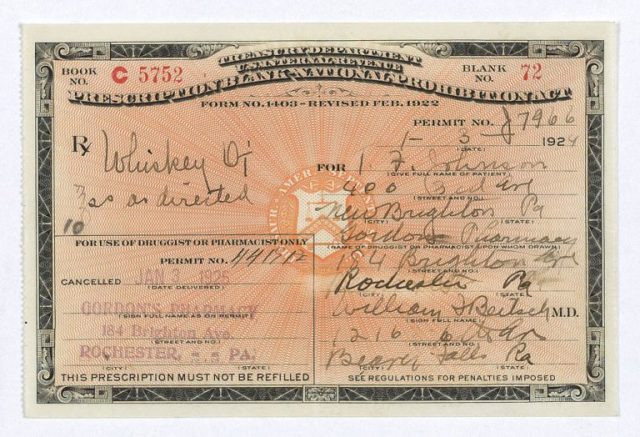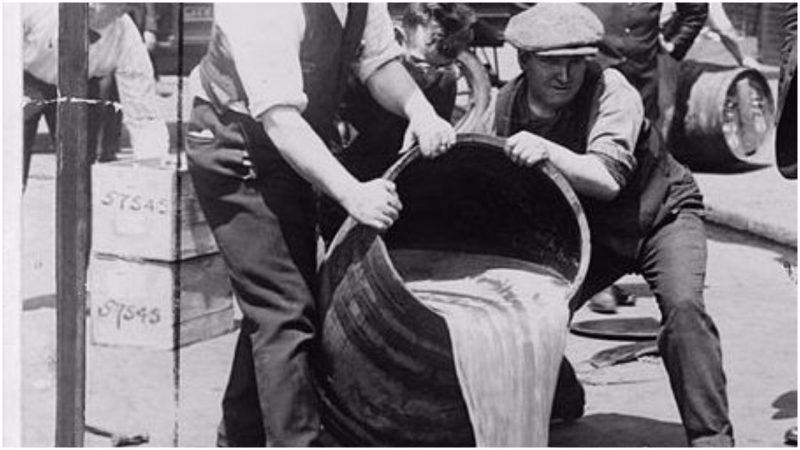“Take three shots of government-stamped whiskey a day, on an empty stomach, and come back in about a week for your second prescription. I suppose you are aware of the fact that alcohol, like all medicines, can cause side effects in some people, especially if not consumed as recommended by a professional. That would be three dollars. See you next week!”
While it is hard to believe that you’ll hear your doctor say something similar today, it seems that this was quite common in the United States after January 16, 1920, when National Prohibition officially began and a doctor’s prescription became the only way one could legally obtain alcoholic beverages.
According to the law, alcohol consumption was allowed, but only if the spirits had been bought before 1920. A great side effect of this law saw some very resourceful Americans finding ways to acquire alcohol, giving way to the emergence of moonshiners and illegal traders of alcohol.
The government fought hard, with a total of 1,520 Federal Prohibition agents employed to ensure no alcohol was present in the country, but their efforts were pointless. During the prohibition era, criminal organizations were effectively given a gateway into earning incredible amounts of money, and consequently, criminal activity increased. Aside from the mafia, another group to prosper financially from prohibition were doctors, who had the power to administer alcohol by prescription.

In that time, alcohol was widely accepted as a form of medication, thus being prescribed by physicians for therapeutic purposes. The doctors in the United States lobbied to make prohibition non-applicable to medicinal liquors. In 1921, there was even a Congress held speaking of the value and benefits of beer for health purposes. Their efforts were successful, and only six months after prohibition was introduced, more than fifteen thousand doctors and fifty-seven thousand pharmacists got their license to prescribe and sell alcohol.
Predictably, thousands of people across the country became very sick in no time. Some of them were actually ill, but most were feigning illness in order to get a prescription for booze. Alcohol was used for the treatment of various conditions and ailments, including tuberculosis, headaches, toothache, high blood pressure, or anemia. To buy spirits from the pharmacy, one had to pay $3 for each prescription, the equivalent of $40 today.
A limit was established on the number of prescriptions per head, so a single patient could only get one prescription per week, paying three dollars for a pint of whiskey, gin or brandy. It is estimated that doctors across the United States earned approximately $40 million during the 13 years of the prohibition period.
The pharmaceutical business grew, and as legal distributors of alcohol, pharmacists also gained greatly in wealth. For example, Walgreens, one of the largest pharmacy chains in the United States, had more than 8,000 stores around the country. The company was established in 1901 in Chicago, and by 1919 there were twenty Walgreen pharmacies in the city. Some 10 years later, the number of their stores amounted to 550 in total, having spread across the entire country. The reason for their expansion was, of course, the Prohibition Act and their trade with alcoholic beverages. Even though the prohibition era ended almost 85 years ago, the company continues to sell alcohol to this day. Neighboring countries like Canada and Mexico, which had no prohibition, also profited from the ban in the United States. The distilleries and breweries in these countries produced alcohol which was either smuggled onto American soil or consumed by the Americans who visited those countries.
On December 5, 1933, the Twenty-first Amendment was ratified, declaring the end of prohibition. Alcohol was once again back in the stores for people to buy freely, and without a doctor’s prescription. It is safe to say that prohibition was an unsuccessful experiment which did not make the country sober, and only helped certain individuals earn vast amounts of money.
Despite the change in the law, certain states decided not to repeal prohibition immediately and instead continued the ban of alcohol for some time. The last state to lift the ban on alcohol trading in the United States was Mississippi, which eventually ended prohibition in 1966.
